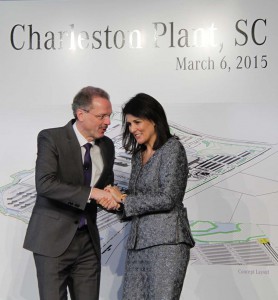
The Mercedes-Benz Sprinter has traditionally been big with contractors, but is gaining demand from the growth of e-commerce.
Mercedes-Benz will invest about $500 million to open a new commercial van plant in the suburbs of Charleston, South Carolina, creating more than 1,300 new jobs in the process.
The facility will handle both the big Sprinter van and the smaller Mercedes-Benz Metris model announced earlier in the week. Company officials told TheDetroitBureau.com that the investment was triggered by a surge in the U.S. van market which reflects the overall rebound of the American economy and, in particular, the boom in e-commerce.
“The e-commerce business has really grown tremendously…and shows much bigger opportunities in the future” for van sales, said Volker Mornhingweg, the head of the German maker’s truck operations.
Mercedes already operates a so-called “knock-down” plant in North Charleston. There, 140 workers complete partially assembled full-size Sprinter vans imported from Germany. The maker sold 26,000 of the big trucks in the U.S. last year, a 30% increase. It currently holds about 9% of the full-size van segment, but it is confident it can significantly boost both sales and share in the coming years.
Building locally, suggested Morninghweg, would shorten supply lines and let Mercedes respond more rapidly to customer needs. It will still import some Sprinter components, but is hoping to have some of its key suppliers set up their own operations in the Charleston area.
(Booming truck sales driving down fuel economy. Click Here for more.)
The Daimler AG subsidiary looked at a number of possible locations before settling on Charleston, including two in Mexico. But officials said the South Carolina site won out because of its access to a major port, good ground transportation access and a supply of well-trained workers.
Appearing at a Friday morning news conference at the existing Mercedes van plant, South Carolina Gov. Nikki Halley said the state did not enter into a bidding war, but simply offered some site logistics assistance and a worker training program. Locally published reports suggested the total state investment will come to around $14 million.
“We’re not a wealthy state. We don’t have the money” to get into the bidding wars seen with other high-profile car plants, said the governor. Nevada, for example, late last year won the “Megafactory” planned by Tesla Motors only after coming up with more than $2 billion in incentives.
Work on the Mercedes van plant will begin sometime in 2016, Mornhingweg said, declining to provide specific details for competitive reasons. He also declined to discuss specific production and capacity numbers.
But with Mercedes currently on target to hit about 30,000 Sprinter sales this year and expecting significant additional growth – and with the Charleston assembly line replacing virtually all Sprinter imports — it is expected that the plant may initially be tooled to handle as much as 50,000 vehicles annually. There is room to further expand the facility if demand grows enough, said Marco Wirtz, the maker’s head of U.S. van manufacturing.
(Click Here to check out 10 of the weirdest automotive accessories ever.)
Mercedes introduced the Sprinter to the U.S. in 2001. Tall and relatively narrow, it marked a distinct shift from the classic, squatty vans that domestic makers had long offered, such as Ford Motor Co.’s Econoline family. The Sprinter quickly clicked with U.S. customers and, over the last several years, a flurry of competitors have come up with similar designs. Ford, for example, recently replaced the aging Econoline with the bigger, European Transit model.
Ford also offers the smaller, European-designed Transit Connect. It will go up against the Mercedes Metris. That model has been offered overseas under the Vito nameplate but is just now making its American debut under the new name – which is meant to suggest its target, “metropolitan” users such as plumbers, bakers and local delivery services.
“It’s the modernization of the entire U.S. van industry,” said Bernie Glaser, head of U.S. truck marketing at Mercedes, describing Sprinter and Metris as a “hub-and-spoke pair.”
For delivery companies like FedEx – which has purchased a number of Sprinters – the big van can be used to handle hub-to-hub deliveries, while the smaller Metris is more suited to reaching the final customer, especially on crowded streets.
As it originally did with the Sprinter, Mercedes will ship partially assembled Metris vans from Europe to Charleston for final assembly. But Mornhingweg said it is possible that if demand grows large enough, the new South Carolina facility could be expanded to build the smaller van from the ground up, as well.
(To see the top 10 debuts at the Geneva Motor Show, Click Here.)

